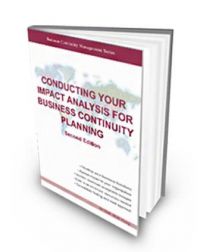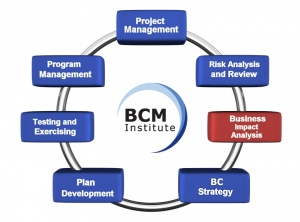Business Impact Analysis (BIA)

2. Process of analyzing activities and the effect that a business disruption might have upon them.
(Source: ISO 22301:2012 – Societal Security – Business Continuity Management Systems - Requirements) - clause 3.8
3. Analysis of impacts of disruption to determine resumption priorities.

(Source: AE/HSC/NCEMA 7000:2021)
4. Process of analyzing business functions and the effect that a business disruption might have upon them.
(Source: British Standard BS25999-1:2006 Code of Practice for Business Continuity Management)
5. The process of determining the impacts on the organization due to interruptions to business operations or processes. The BIA should qualify and/or quantify losses as a result of such interruptions. Where possible, the loss impact should include both business disruption (number of days) and financial standpoints. BIA is determined without consideration for risk source, type or magnitude.
(Source: Singapore Standard 540 - SS 540:2008)
6. The management level analysis by which an organization assesses the quantitative (financial) and qualitative (non-financial) impacts, effects and loss that might result if the organization were to suffer a Business Continuity E/I/C. The findings from a BIA are used to make decisions concerning Business Continuity Management strategy and solutions.
(Source: Business Continuity Institute - BCI)
7. The process of analyzing all business functions and the effect that a specific disaster may have upon them. 1) Determining the type or scope of difficulty caused to an organization should a potential event identified by the risk analysis actually occur. The BIA should quantify, where possible, the loss impact from both a business interruption (number of days) and a financial standpoint. SIMILAR TERMS: Business Exposure Assessment, Risk Analysis.
(Source: Disaster Recovery Institute International / Disaster Recovery Journal - DRII/DRJ)
8. A management level financial analysis that identifies the impacts of losing an organization’s resources. The analysis measures the effect of resource loss and escalating losses over time in order to provide reliable data upon which to base decisions on mitigation, recovery, and business continuity strategies
(Source: ASIS International - ASIS International)
9. A management level analysis, which identifies the impacts of losing company resources. The BIA measures the effect of resource loss and escalating losses over time in order to provide senior management with reliable data upon which to base decisions on risk mitigation and continuity planning. (Associated terms:Business Impact Assessment,Business Impact Analysis Assessment).
(Source: HB 221:2004 Business Continuity Management)
(Source: Australia. A Practitioner's Guide to Business Continuity Management HB292 - 2006 )
10. A management level analysis that identifies the impacts of losing the entity's resources.
(Source: NFPA 1600 Standard on Disaster/Emergency Management and Business Continuity Programs, NFPA 1600:2007)
11. The process of analyzing the financial and non -financial impact due to a disruption on business operations. The BIA measures the effect of resource loss and escalating losses over time in order to provide top management with reliable data upon which to base decisions on Risk Mitigation and continuity planning.
(Source: Malaysia BCM Standard MS1970:2007)
12. A management level analysis, which evaluates the risks of disruption, including a consideration of the impacts of capability loss over time and the needs for and inter-dependencies of resources.
NOTES:
- The BIA measures the effect of capability loss, including escalating losses over time and effects on inter-dependencies, in order to provide senior management with reliable data upon which to base decisions on risk treatment and planning for stabilization, continuity and recovery
- Also referred to as business impact assessment.
(Source: AS/NZS 5050.1 Australian and New Zealand Standards for business continuity management.
Part 1: Business continuity management system specification)
13. A management level analysis, which evaluates the risks of disruption, including a consideration of the impacts of capability loss over time and the needs for and inter-dependencies of resources.
NOTES:
- The BIA measures the effect of capability loss, including escalating losses over time and
effects on inter-dependencies, in order to provide senior management with reliable data upon which to base decisions on risk treatment and planning for stabilization, continuity and recovery
- Also referred to as business impact assessment.
(Source: AS/NZS 5050.2 Australian and New Zealand Standards for business continuity management.
Part 2: Business continuity management practice standard)
14. An assessment of the minimum level of resources e.g. personnel, workstations, technology, telephony required, overtime, after a Business Continuity Incident to maintain the continuity of the organisation's Mission Critical Activities at a minimum level of service/production. The BIA measures the effect of resource loss and escalating losses over time in order to provide senior management with reliable data upon which to base decisions on risk mitigation and continuity planning. Generally considered to be part of a BIA it is an integral part of any subsequent resource Gap Analysis.
(Source: Business Continuity Institute - BCI)



